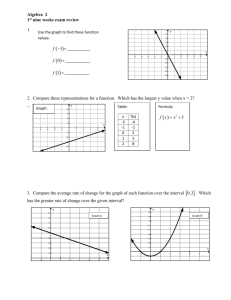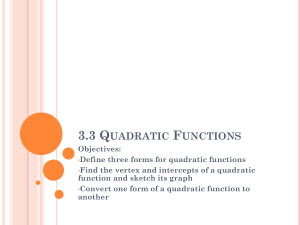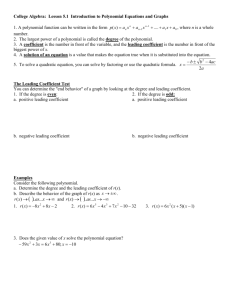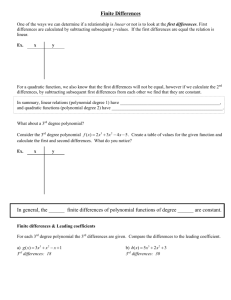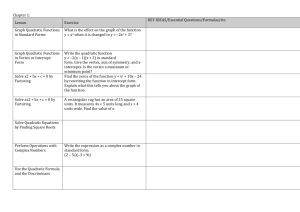Precalculus 1 - Mercer Island School District
advertisement
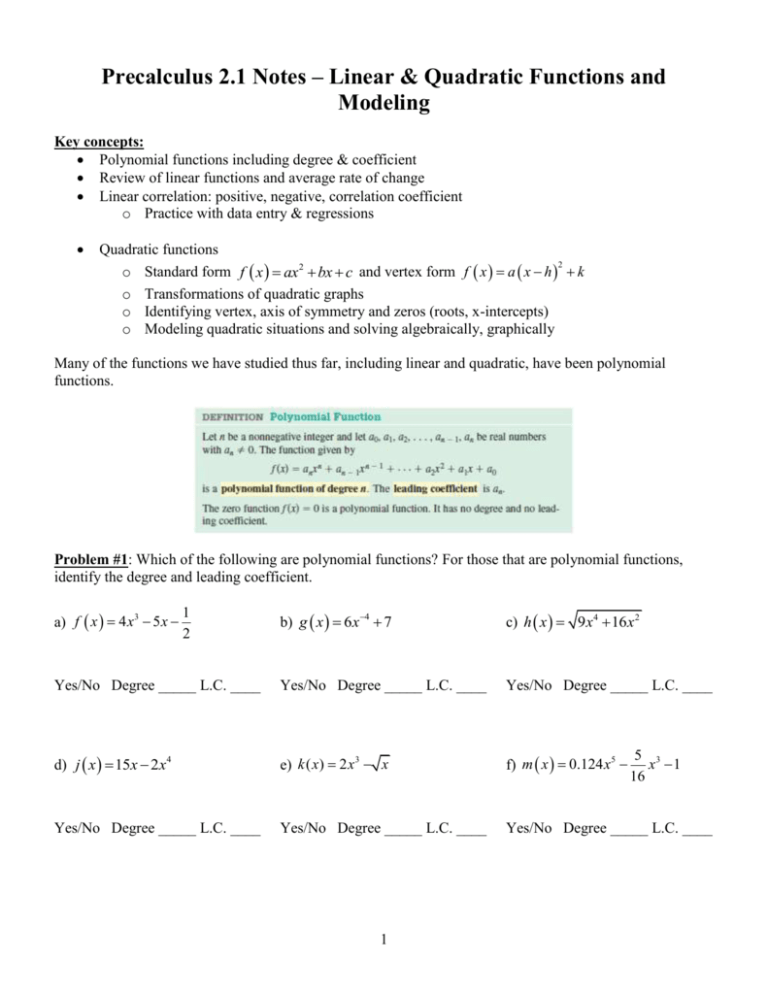
Precalculus 2.1 Notes – Linear & Quadratic Functions and Modeling Key concepts: Polynomial functions including degree & coefficient Review of linear functions and average rate of change Linear correlation: positive, negative, correlation coefficient o Practice with data entry & regressions Quadratic functions 2 o Standard form f x ax2 bx c and vertex form f x a x h k o Transformations of quadratic graphs o Identifying vertex, axis of symmetry and zeros (roots, x-intercepts) o Modeling quadratic situations and solving algebraically, graphically Many of the functions we have studied thus far, including linear and quadratic, have been polynomial functions. Problem #1: Which of the following are polynomial functions? For those that are polynomial functions, identify the degree and leading coefficient. 1 2 b) g x 6 x 4 7 c) h x 9 x 4 16 x 2 Yes/No Degree _____ L.C. ____ Yes/No Degree _____ L.C. ____ Yes/No Degree _____ L.C. ____ d) j x 15x 2 x4 e) k ( x) 2 x 3 x f) m x 0.124 x 5 Yes/No Degree _____ L.C. ____ Yes/No Degree _____ L.C. ____ Yes/No Degree _____ L.C. ____ a) f x 4 x 3 5 x 1 5 3 x 1 16 The zero function and all constant functions are polynomial functions. Some other familiar functions are also polynomial functions, as shown below. Problem #2: What is the slope of the above four polynomial functions? Linear Functions: A linear function is a polynomial function of degree 1 and so has the form f x ax b , where a and b are constants and a 0 . If we use m for the leading coefficient instead of a and let y f x , then this equation becomes the familiar slope-intercept form of a line: y mx b . Vertical lines are not graphs of functions because they fail the vertical line test, and horizontal lines are graphs of constant functions. A line in the Cartesian plane is the graph of a linear function if and only if it is a slant line that is, neither horizontal nor vertical. Problem #3: Write an equation for the linear function, f, such f 1 2 and f 3 2 . Another property that characterizes a linear function is its rate of change. The average rate of change of a f b f a function y f x between x a and x b , a b is: . Because the average rate of change of a ba linear function is constant, it is called simply the rate of change of the linear function. The slope m in the formula f x mx b is the rate of change of the linear function. 2 Linear correlation and modeling: Figure 2.2 shows five types of scatter plots. When the points of a scatter plot are clustered along a line, we say there is a linear correlation between the quantities represented by the data. When an oval is drawn around the points in the scatter plot, generally speaking, the narrower the oval, the stronger the linear correlation. When the oval tilts like a line with positive slope (as in Figure 2.2a and b), the data have a positive linear correlation. On the other hand, when it tilts like a line with negative slope (as in Figure 2.2d and e), the data have a negative linear correlation. Some scatter plots exhibit little or no linear correlation (as in Figure 2.2c), or have nonlinear patterns. A number that measures the strength and direction of the linear correlation of a data set is the (linear) correlation coefficient, r. In economics, a linear model is often used for the demand for a product as a function of its price. For instance, suppose Twin Pixie, a large supermarket chain, conducts a market analysis on its store brand of doughnut-shaped oat breakfast cereal. The chain sets various prices for its 15-oz box at its different stores over a period of time. Then, using this data, the Twin Pixie researchers project the weekly sales at the entire chain of stores for each price and obtain the data shown in Table 2.2. 3 Problem #4: Use the data in Table 2.2 to write a linear model for demand (in boxes sold per week) as a function of the price per box (in dollars). Describe the strength and direction of the linear correlation. Then use the model to predict weekly cereal sales if the price is dropped to $2.00 or raised to $4.00 per box. Quadratic Functions and Their Graphs: A quadratic function is a polynomial function of degree 2. Recall from Section 1.3 that the graph of the squaring function f x x2 is a parabola. We will see that the graph of every quadratic function is an upward or downward opening parabola. This is because the graph of any quadratic function can be obtained from the graph of the squaring function f x x2 by a sequence of translations, reflections, stretches, and shrinks. Problem #5: Describe how to transform the graph of f x x2 into the graph of the given function. Sketch its graph by hand. 1 g x x2 3 2 h x 3 x 2 1 2 4 Problem #6: Rewrite f x 6 x 3x2 5 in vertex form. What is the vertex? What is the axis of symmetry? Problem #7: Use the weekly demand model y 15358.93 x 73622.5 (from Problem #4) to develop a model for the weekly revenue generated by doughnut-shaped oat breakfast cereal sales. Determine the maximum revenue and how to achieve it. 5 Vertical Motion of a Body in Free Fall: Since the time of Galileo Galilei (1564–1642) and Isaac Newton (1642–1727), the vertical motion of a body in free fall has been well understood. The vertical velocity and vertical position (height) of a free-falling body (as functions of time) are classical applications of linear and quadratic functions. These formulas disregard air resistance, and the two values given for g are valid at sea level. We apply them from time to time throughout the rest of the book. Problem #8: The data in Table 2.3 were collected in Boone, North Carolina (about 1 km above sea level), using a Calculator-Based Ranger™ (CBR™) and a 15-cm rubber air-filled ball. The CBR™ was placed on the floor face up. The ball was thrown upward above the CBR™, and it landed directly on the face of the device. Use the data in Table 2.3 to write models for the height and vertical velocity of the rubber ball. Then use these models to predict the maximum height of the ball and its vertical velocity when it hits the face of the CBR™. 6
